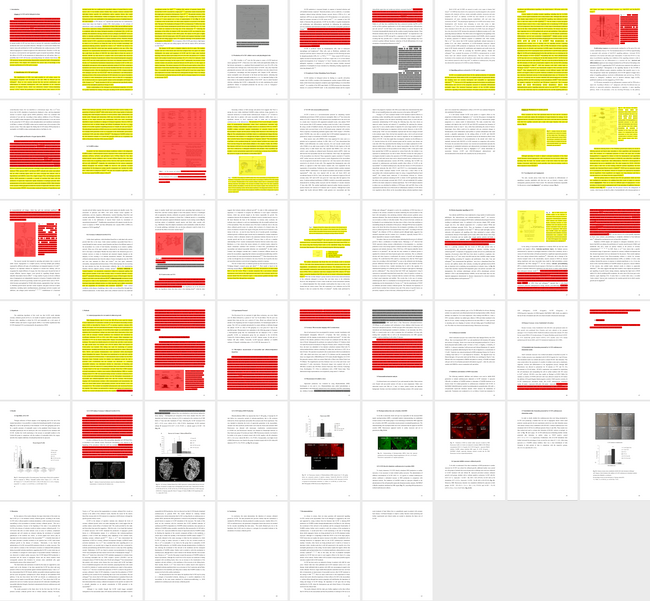Findings
- Problematic text parallels can be found in the following chapters:
- 1. Introduction
- Chapter I: G-CSF and its biological actions (p. 12 [beginning]): page 12
- I.1 Identification of G-CSF and its gene (p. 12-15): pages 12, 13, 14, 15 – [almost completely]
- I.2 Production of G-CSF: cellular sources and physiological roles (p. 15-16): page 16
- I.3 Granulocyte-Colony Stimulating Factor Receptor (p. 16-18): page 17
- I.4 Signalling pathways activated by G-CSF and its receptor (p. 18-21): pages 18, 19, 20
- I.5 Neutrophils and Reactive Oxygen Species (ROS) (p. 21-22): pages 21, 22 – [completely]
- I.6 NADPH oxidase (p. 22-24): pages 22, 23, 24 – [almost completely]
- Chapter II: Mechanisms of vascular growth (p. 28 [beginning]): page 28 – [completely]
- Chapter I: G-CSF and its biological actions (p. 12 [beginning]): page 12
- 3. Methods
- 3.1 Animal preparation for rat model of collateral growth (p. 40-41): pages 40, 41 – [completely]
- 3.2 Mini-Pneumatic Snare Occluder for Rat Heart (p. 41): page 41 – [completely]
- 3.2 [sic] Microsphere measurements of myocardial and collateral-dependent blood flow (p. 42-43): pages 42, 43 – [completely]
- 3.4 Measurement of oxidative stress (p. 43-44): page 44
- 3.9 Endothelial tube formation promoted by G-CSF cardiomyocyte stimulation media (p. 46-47): pages 46, 47
- 3.9 [sic] Data analysis (p. 47): 47 – [completely]
- 4. Results
- 1. Introduction
- The images and tables in chapters 1-3 (without a single exception) have been copied from other publications without naming the source. In every single instance another source is given that however does not contain the copied material: Fig. 1, Fig. 2A, Fig. 2B, Fig. 3, Fig. 4, Fig. 5, Fig. 6, Fig.7, Fig. 8A, Fig. 8B, Fig.9, Fig. 10, Fig. 11, Tab. 1
Prominent fragments
- Fragment 019 01: An entire page including 9 references to the literature have been taken from a source that is only mentioned at the end of the page.
- Fragment 021 11: Substantial text and two references to the literature have been copied without naming the source.
- Fragment 032 11: This fragment is an example for an image that has been copied without naming the source.
- Fragment 049 02: This fragment is remarkable because it documents a substantial text parallel in the chapter "4. Results". The source is not mentioned.
Prominent sources
- Demetri & Griffin (1991): substantial text parallels with a source that was 18 years old at the time of writing.
- Toyota et al. (2005): substantial parts of the methods section are taken from this source.
- Ward et al. (1999), Liu et al. (2008): Most sources are mentioned in the bibliography, these two sources, however, are not mentioned anywhere in the thesis.
Other observations
- The section numbers 3.2, 3.3 and 3.9 have been assigned twice.
Statistic
- Currently there are 41 reviewed fragments documented that are considered to be violations of citation rules. For 25 of them there is no reference given to the source used („Verschleierungen“ and „Komplettplagiate“). For 16 fragments the source is given, but the extent of the used text is not made clear („Bauernopfer“).
- The publication has 51 pages that have been analyzed. On a total of 32 of these pages violations of citation rules have been documented. This represents a percentage of 62.7%. The 51 analyzed pages break down with respect to the amount of text parallels encountered as follows:
- From these statistics an extrapolation of the amount of text of the publication under investigation that has been documented as problematic can be estimated (conservatively) as about 26% of the main part of the publication.
- In all, text was taken from 21 sources.
Illustration
The following chart illustrates the amount and the distribution of the text parallel findings. The colours show the type of plagiarism diagnosed:
- grau="Komplettplagiat" (copy & paste): the source of the text parallel is not given, the copy is verbatim.
- rot="Verschleierung" (disguised plagiarism): the source of the text parallel is not given, the copied text will be somewhat modified.
- gelb="Bauernopfer" (pawn sacrifice): the source of the text parallel is mentioned, but the extent and/or the closeness of the copy to the source is not made clear by the reference.
